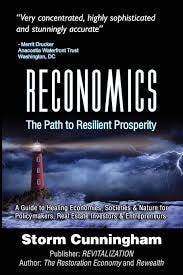Charting The Economic Recovery Storm
The economic impact of the Covid-19 pandemic on cities and regions has been profound. For mayors, economic development professionals, urban planners, and city leaders, it has been a defining moment, a turning point, and a once-in-a-lifetime challenge.
The crisis has resulted in significant economic disruption, worsened inequality, massive fiscal uncertainty for state and local governments. As communities struggle with vaccine rollout and other measures to mitigate the spread of the disease, leaders must remain dialed into broader solutions for economic recovery.
The operative question though is what will this recovery trajectory look like. Moreover, how can public leaders and community stakeholders ensure a more inclusive and effective process as we move toward a post-pandemic future?
For answers to these questions, we turned to Storm Cunningham, Executive Director of Washington, DC-based RECONOMICS Institute. He's also the editor of the institute's journal, REVITALIZATION.
I’ve known Storm for years having picked up his book while traveling as an urban/economic development journalist in 2009. Since 2002, Storm has worked as a full-time urban/rural/regional turnaround expert, assisting mayors, housing authorities, Chambers of Commerce, and social/environmental non-profits with strategic analysis and revitalization support.
When asked about what he’s witnessed in terms of local attempts at recovery or resilience over the years, Storm didn’t mince words in offering a quick, no holds barred assessment:
“About 90% of urban and regional economic recovery efforts fail.”
It’s here where he touts the work of the RECONOMICS Institute in strengthening urban, rural, and natural places worldwide through the training and certification of Revitalization & Resilience Facilitators (aka RE Facilitators). These public and private professionals, he says, provide the crucial missing ingredient for success which is a strategic process.
“Most communities have numerous projects that contribute to revitalization and resilience. But they lack a proven, ongoing process to reliably produce the desired end result: lasting economic, social and environmental renewal. That’s where we come in.”
Resilience, according to Storm, is produced via the repurposing, renewal, and reconnection of our natural, built socioeconomic assets. Revitalization, he says, is produced in exactly the same way.
“Failure to integrate these two mutually reinforcing goals is a key reason most resilience and revitalization initiatives fail. Integrating them weds the short-term benefits of revitalization with the long-term benefits of resilience, increasing funding and public support for both.”
A tool for bringing awareness to this is Storm’s newest book RECONOMICS: The Path To Resilient Prosperity. It outlines a process of integration and synergy that allows for leaders and community stakeholders to achieve resilience and revitalization simultaneously.
RECONOMICS, says Storm, is the first book that focuses on achieving crisis recovery, economic growth, and community resilience simultaneously. It reveals the surprising factor that can lead to the tripling of ROI when it comes to renewal efforts.
“The book was released early last year so it’s been out for about a year and a half now. It follows the other two that I wrote which are The Restoration Economy and Rewealth.”
Continues Storm:
“RECONOMICS was the first time that an actually proven, reliable process for revitalizing places and making them more resilient was actually documented. In the past, I’ve focused more on projects and disciplines, and activities. Like in the Restoration Economy which was all about the different kinds of disciplines and industries and projects involved in restoring and revitalizing different assets.”
Storm says that his over 25 years of research have revealed the deeper, underlying reasons why few cities and regions experience dramatic, lasting (resilient) revitalization. This is despite impressive plans and massive redevelopment investments that have been proposed by these cities.
“Communities never have had a template to work from where they could take a look at what they’re doing. Often they are missing this element and that element. So I documented those in the book to provide city leaders with a blueprint for their resilience and recovery efforts.”
One emerging trend that Storm says he’s seeing as a result of Covid is that everyone is trying to engage in a recovery process at the same time.
“This makes for a different situation. It’s forcing communities to think, ‘well if we are doing exactly what everyone else is doing how is that really going to improve our situation vis a vis the whole. What can we do that’s different? What can we do that’s better and will really make us stand out.’”
These are the sorts of questions that Storm covers in the book:
“The goal shouldn’t be to achieve a whole bunch of projects. What you want to achieve is revitalization and resilience. So the question becomes where is the process for actually achieving this. Because everyone on the face of the planet knows that to reliably produce anything, you have to have a process. But at times, our public leaders don’t seem to understand that.”
With respect to his greatest hope for those who read RECONOMICS, Storm concludes:
“This book is the holy grail in terms of what I’ve been shooting for in terms of our work resilience work. Thinking ahead, I will likely publish a second edition because the biggest weakness of the current edition is that it doesn’t have enough examples of this process in action. This makes sense given that the process around revitalization and resiliency has never been previously documented.”





